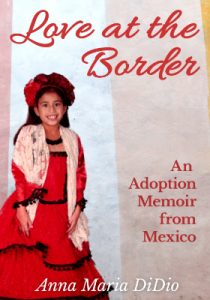It’s the Right Time for Love at the Border
 When I heard that my company was for sale, it was the worst possible news. I was head of Human Resources which meant that we wouldn’t be hiring anyone or initiating any new projects. What was I going to DO for the next year or so that I knew it would take to ready the company for acquisition?
When I heard that my company was for sale, it was the worst possible news. I was head of Human Resources which meant that we wouldn’t be hiring anyone or initiating any new projects. What was I going to DO for the next year or so that I knew it would take to ready the company for acquisition?
During my train ride to work each morning, I recorded these thoughts in my journal. It was a compact little book with a blue ribbon to mark my place. Inside were miscellaneous musings plus the sayings, observations and frustrations of my life in general. Recently, however, those notes included my thoughts and concerns about a very specific family struggle that led to a life-changing event.
The summer before, my husband Richard and I, adopted a seven-year-old girl from an orphanage in Cuernavaca, Mexico.
However, when Priscilla arrived in our home, she cried for months, pleading in Spanish to return to her homeland and the only mother she had ever known. We had an eight-year-old biological child and it was my wish for her to have a sister as I had. For months, I told myself that it was only a matter of time until the two of them would begin to form that sisterly bond.
I was also on pins and needles waiting for Priscilla to accept me as her mother – to show us that she wanted to be part of our family. During that time, we had many moments when it was not even clear if the adoption would work out. I kept writing about it though. It was almost as if I had to explain things to myself.
My notes evolved into stories and during one creative burst, while on vacation, I realized that these stories could be a book. I outlined the chapters on a steno pad and carried that paper with me everywhere, crossing out and adding to it until the sheets were grimy and ripped. A very rough and wordy first draft followed. The spiral notebook eventually filled up. My brain seemed to work better when I had a few moments to sketch something out with a pen. Later I would fill in the gaps when I worked on my computer.
On weekends, I took my laptop to the local library to type for a few hours in the mornings. Initially, I gave everyone in the book a fictitious name. It felt somehow safer that way. I was honest, but not too honest. My struggles with infertility, multiple miscarriages, and impatience with the whole adoption process were all written with arms-length detachment.
Meanwhile, a new job demanded more. My commute doubled, only this time I was driving and couldn’t write anything on the way to work. I put the draft away for a few years, but, kept journaling because the nuggets for stories within my story were a constant backdrop of our family routine.
Priscilla’s life in the United States was full of sometimes funny, sometimes heartbreaking dialogue, sights and sounds and I captured them all in my crazy shorthand. The biggest disappointment was that our adoption experience was not unfolding as I had hoped. Would Priscilla ever be happy that she was part of our family?
When life settled, I pulled out my draft chapters and reached out to Liz, a poet and creative writing professor. She agreed to read my draft but began first by asking me why I wrote the book.
In the beginning it was cathartic to rail in writing. It helped to tamp down the anger I felt about not being able to have more children. But there were more targets: my disappointing relationship with my mother who never “got” me, my waning Catholic faith, and my daughters’ animosity toward one another no matter how much love and effort I poured into their relationship.
Liz’s message was clear: I was telling too many stories. What did I need to communicate about this journey? Where was my focus? We suffered through a few drafts together.
From there I worked with Raquel, a development editor whose questions about transparency helped me to create a more authentic manuscript. She pinpointed those areas in which I had not revealed enough of my feelings and motives for the adoption. Without those profoundly personal questions answered in a satisfactory way, the book would be superficial and not of interest to memoir readers.
I changed everyone’s name back to their real ones which helped me cut right to the heart of the memoir. Could I love a child from another culture? Why didn’t the sisters get along? How did our marriage survive the ordeal? Amazingly, ten years had passed since I started writing. With reflective and intense honesty, I added depth to my story.
Our journey began over fifteen years ago, and the world is now a different place. Today, the word border has overtones of hatred and prejudice that have been leveled specifically at Mexicans. At the same time, Priscilla has created her own border of feelings for her new family, her two countries. She is intent on discovering who she is and, in finding the key from her past, is discovering what it means to love.
In writing our story, I want to expand the conversation around adoption, blended families, and say something positive about Mexico. My hope is that this book will be the spark for conversations about love, kindness, diversity and tolerance for borders of all kinds.
—
ANNA MARIA DIDIO: Anna Maria holds her BA in Psychology from Villanova University, and MSW in a Family Specialization from the University of Pennsylvania. As an HR consultant, author and speaker, she has coached senior leaders across many industries and is a trusted advisor on all human capital matters. Throughout her career, she has also devoted her time and talents to many non-profit organizations focusing on women, girls and families. Anna Maria lives with her husband Richard in Philadelphia. Love at the Border is her first book. For more information, see her website: amdidio.com and Medium@AnnaMariaDiDio
For more please visit: www.amdidio.com
Twitter: @amdidio
Medium: @AnnaMaria.DiDio
Love at the Border, An Adoption Memoir from Mexico
 On Sunday, Priscilla was a seven-year-old orphan living in Mexico. On Monday, she found herself in suburban Philadelphia beginning a new life. Instead of a happy ending, Priscilla cried and pleaded in Spanish to return to the woman who raised her.
On Sunday, Priscilla was a seven-year-old orphan living in Mexico. On Monday, she found herself in suburban Philadelphia beginning a new life. Instead of a happy ending, Priscilla cried and pleaded in Spanish to return to the woman who raised her.
Love at the Border provides a rare look into the international adoption of an older child and speaks to all blended families as mother and daughter endeavor to bridge two worlds. This true story of love, loss, trust, and survival is a powerful testament to family and our need to belong. Women on both sides of the border – and ultimately Priscilla herself – must discover the key to her past that will provide a future full of the love she wants and deserves.
Category: On Writing

























